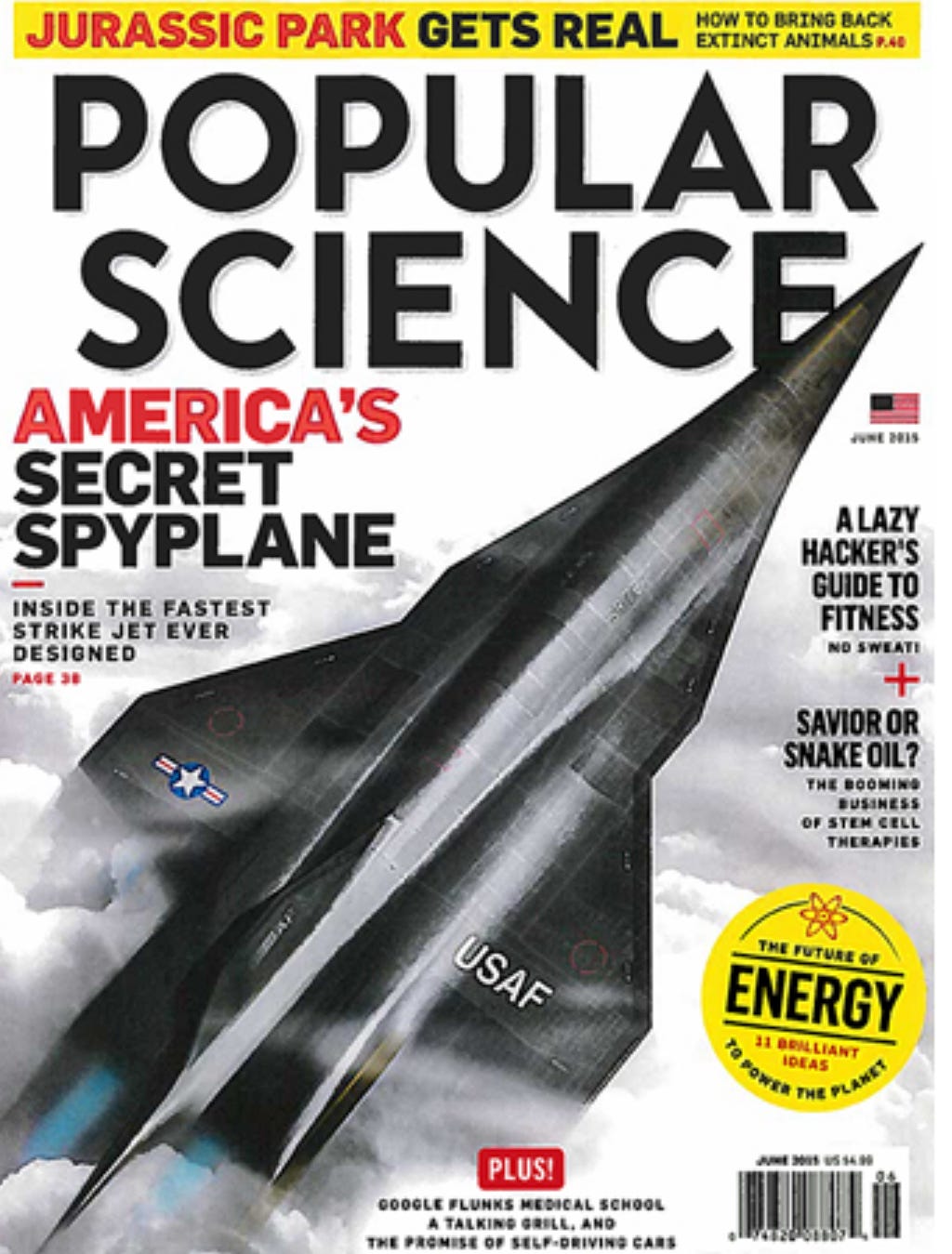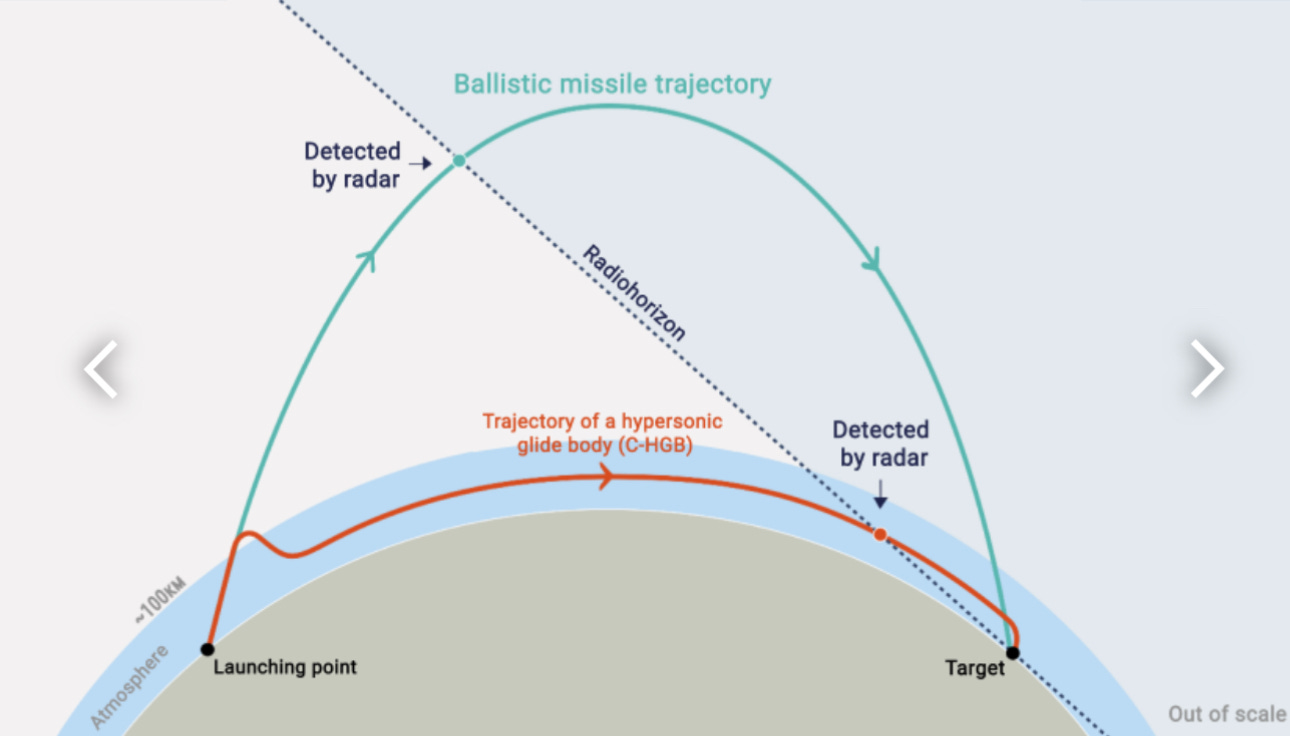Black Budgets, Secret Jets, UFOs — And a $12 Dividend
This defense firm is driving one heck of a "New Cold War" storyline ...
In an Instagram story last summer, the U.S. defense giant known for missiles and jets stunned everyone by dropping a bomb.
The company: Lockheed Martin Corp. LMT 0.00%↑, builder of the sub-warfare-revolutionizing Polaris missile, and such breakthrough combat planes like the P-38 Lightning, the SR-71 Blackbird and the F-117A Nighthawk Stealth Fighter.
The occasion: The 80th anniversary of its famed Skunk Works unit — kind of a defense-industry “Mad-Scientist’s Lab” that’s minted some of the America’s best combat planes over that eight-decade stretch.
And that “bomb-shell:” Lockheed’s Instagram “slide show” spotlighted some of the great aircraft the Skunk Works has delivered — with a final image (see photo from earlier) of a futuristic jet that doesn’t officially exist. Did the company “sneak in” a sketch of the futuristic jet it’s working on for the U.S. Air Force’s super-secret/next-generation fighter program?
That image whipped up one heck of a buzz. And the “plot” of this New Cold War airplane story has thickened since then.
And it’s for a good reason.
There’s been a ton of interest in this initiative — known in Pentagon-speak as the “Next-Generation Air Dominance” (NGAD) program. The Air Force is right now analyzing the cost and feature levels of these stealthy, “sixth-generation” jets, which could run $200 million to $250 million each. It could push ahead with NGAD, or use what it learned to develop a leaner, cheaper (but still-advanced) jet.
In conjunction with the Lockheed F-35 Lightning II, upgraded F-15 Strike Eagles — and probably 1,000 artificial-intelligence-infused “loyal wingman” drones — the NGAD fighter or its offshoots could help define the future of aerial combat.
The intrigue surrounding this program has been massive. Back in 2020, Will Roper, then an assistant secretary for the USAF, said that “demonstrator” versions of the NGAD jet had already flown — and “broken lots of records in the process.”
Nor is this the only “black budget” (top secret) aircraft program Lockheed is involved with (that we know about). Subsequent sightings of “unexplained” aircraft have been attributed, in part, to Skunk Works projects — including NGAD … and this wild-blue-yonder hot rod:
This Popular Science “cover shot” depicts the SR-72 ‘Son of Blackbird” spy plane, a project I’ve been following for more than a decade. Artists’ renderings have adorned magazine covers. And in late July 2017, a mysterious jet (escorted by two military jets) flew into the Air Force’s secretive Building 42 Palmdale, Calif., plant – where the Skunk Works is located. Experts believe the jet was a scaled-down test version of the SR-72, which could fly manned or unmanned, exceed Mach 6, be loaded with America’s most-advanced sensors, and give the Pentagon near-real-time looks at such hot spots as China, Iran, North Korea or Russia during moments of maximum stress.
These are stories I’ve followed for years, and they’re as intriguing as hell. And I mention them here because they make an important point about Lockheed, a company that — thanks to its $134 billion market value and $71 billion in annual revenue — would seem to be rather “still” in terms of growth.
But (as the old adage tells us), “still waters run deep.”
And as the New Cold War deepens before our eyes, Lockheed is one of the defense giants best-positioned to capitalize.
“Trouble” and “Trillions” — The Terrible T’s
The core Stock Picker’s Corner (SPC) “Wealth Builder” strategy is “find the best storylines and you’ll find the best stocks.” And when multiple storylines intersect — like here with the New Cold War and AI — that Wealth Builder potential is even stronger.
Global military spending jumped 3.7% in 2022 to hit a record $2.24 trillion, says the Stockholm International Peace Research Institute (SIPRI), the think tank that’s one of the leading independent experts on global security issues. And that spending will keep growing — approaching $3.3 trillion by decade’s end, SIPRI says.
The three largest spenders — the United States, China and Russia — accounted for 56% of that $2.24 trillion total. The United States is far and away the world’s No. 1 military spender. U.S. outlays hit $877 billion in 2022 – 39% of total global military spending and three times the $292 billion spent by China, the No. 2 player in military budgets.
America spent $916 billion on the military last year.
Military spending has helped rev China up into a true superpower. That $292 billion for 2022 was 4.2% more than in 2021. And it was 63% more than in 2013, SIPRI says.
If you include the estimated $296 billion spent last year, Beijing has boosted China’s military budget for 29 years in a row.
“The continuous rise in global military expenditure in recent years is a sign that we are living in an increasingly insecure world,” Prof. Nan Tian, senior researcher with SIPRI’S Military Expenditure and Arms Production Programme, said of the numbers. “States are bolstering military strength in response to a deteriorating security environment, which they do not foresee improving in the near future.”
A “Hyper” Arms Race
As the son of a Cold War engineer — and a business reporter, analyst and stock picker who’s followed defense/aerospace issues for decades — military history, global security and military technology is one of my areas of expertise.
And I’ve brought that expertise to you here at SPC.
In a recent New Cold War report about Russia and China’s tightening ties, I promised that I’d follow up with several defense stocks. I told you about Palantir Technologies Inc. PLTR 0.00%↑. And now I’m following up further with this report on Lockheed.
(One of our Model Portfolio recommendations is a New Cold War play whose technology can give America a massive technical “edge.”)
The New Cold War has added battlegrounds in cyberspace and outer space. It’s shifted the prospective battleground from Europe and the “Fulda Gap” to the South China Sea.
And Lockheed is absolutely one of the best-positioned defense giants — with technology and weapons systems that are key to these New Cold War threats and battlegrounds of the future.
First and foremost, you’ve got drones – unmanned airplanes, ships and ground-traveling vehicles whose lack of human drivers keeps those soldiers safe. It’s NGAD and “Son of Blackbird” jets are apparently being designed to be flown both ways — piloted and pilot-free.
Then we have hypersonics, one of the big new threats — and a potential big new arms race — here in the New Cold War. Here we’re talking about weapons that can reach speeds of Mach 5 to Mach 25 – or five to 25 times the speed of sound. With promised speeds of Mach 6 plus, the “Son of Blackbird” would qualify as a hypersonic aircraft. China, Russia and America have all developed hypersonic missiles.
China has developed an ocean-skimming, anti-ship hypersonic missile known as the “Carrier Killer” – designed specifically to clobber U.S. aircraft carriers in a showdown over Taiwan in the South China Sea. The Carrier Killer’s on-the-deck flight path and hypersonic speed will be tough to detect, creating new challenges for U.S. Navy carrier strike groups.
But one of the real “next-gen” threats is the hypersonic glide vehicle (HGV), also known as a hypersonic boost glider. The nuclear-tipped, intercontinental ballistic missiles (ICBMs) that have been deployed for decades travel a predictable trajectory — a parabolic path from launch to target that makes interception possible.
But HGVs combine hypersonic speeds with defense-evading maneuverability, an innovation that can neutralize today’s missile interceptors (see diagram below).
And the global power that’s the first to truly perfect the HGV could find itself with “first-strike” advantage.
Lockheed has developed hypersonic missiles.
But America – which pioneered hypersonic technology — has surrendered some of that leadership to China and Russia. And it’s working on new ways to detect and defend against them.
Lockheed is working on hypersonic strike and defense technologies. In May, for instance, the U.S. Army gave the company a $756 million contract to continue development of the Long-Range Hypersonic Weapons (LRHW) missile batteries. And it’s working on the Air Force’s Air-Launched Rapid Response Weapon (ARRW), a hypersonic missile that can be launched from combat planes.
And Lockheed is also known for THAAD, the Terminal High Altitude Area Defense system — a ballistic-missile-interceptor system that boasts one of the most-sensitive sensor/radar sensors in the world.
That’s just a sampling. And, as always, I’ve intentionally oversimplified the concepts … and the technologies … distilling them to a retail-investor level.
But this is certainly enough to show you that Lockheed is a player in most of the key defense technologies needed here in the New Cold War.
Headlines: Both Big and Strange
I talk about “finding the best storylines.” With the New Cold War and Lockheed, those stories are in the headlines every day.
There’s the Russia/Ukraine War — and the accelerating use of drones. In mid-February, defense analysts confirmed the first use of Russia’s Zircon hypersonic missile, which has a range of 625 miles and flies at Mach 9.
We’re seeing the use of drones, missiles and missile-defense systems in the Israel-Hamas War.
And new systems are being tested all the time — many of them in secret.
Want a fun fact? Or a strange story?
Last weekend, scores of residents in the Palmdale-Lancaster region of California reported UFO sightings – sharing the reports on the Ring neighborhood app.
Interestingly, the Federal Aviation Administration (FAA) has issued a special security alert for the area’s airspace.
And let’s not forget: Palmdale is the home of Plant 42, the Skunk Works headquarters, and Edwards Air Force Base, where just about every major U.S. military airplane since World War II has undergone at least some testing.
The locale may be a mere coincidence. And those alleged “sightings” may be much ado about nothing.
But the other current events — in Russia, in the Middle East and in the Pacific — are real. And they do tell us that the ongoing geopolitical mess is a key catalyst for New Cold War defense spending on a global basis.
That Gorgeous “Trifecta”
Watch what the United States is doing. Watch what America’s allies are doing. Lockheed is a proxy for all of this.
For its just-reported second quarter, Lockheed said net sales surged 9% to $18.1 billion. Net earnings came in at $1.6 billion, or $6.85 a share, up from profits of $1.7 billion, or $6.63 a share last year.
It boosted its full-year guidance on revenue (to a range of $70.5 billion to $71.5 billion from its April forecast of $68.5 billion to $70 billion) and earnings per share (to a range of $26.10 to $26.60 from the April projection of $25.65 to $26.35).
Lockheed achieved what I’ve nicknamed the “earnings report trifecta:” It beat on revenue and profits – and boosted its guidance.
Its backlog is right now about $160 billion – or more than two years’ worth of revenue (net sales were $67.6 billion in 2023).
Cash from operations rose – from $1.1 billion last year to $1.9 billion this year. Free cash flow more than doubled – from $771 million in the second quarter of 2023 to $1.5 billion in the second three months of 2024.
Between dividends and buybacks, the company funneled $1.6 billion back to shareholders in that second quarter. (Lockheed returned $9.1 billion to shareholders for all of 2023).
The dividend yield is 2.25%. But the $12.60 a share in actual cash could add up quickly — for use buying other stocks.
It’s a New Cold War stock that we’ll keep watching …
And I’m looking at others, as well.
See you next time …










Check out defense writer Tyler Rogoway's follow-up story about the "UFO angle" on this tale ...
https://www.twz.com/air/palmdale-ufo-scare-leads-to-revelations-about-mystery-drone-incursions-over-secretive-plant-42